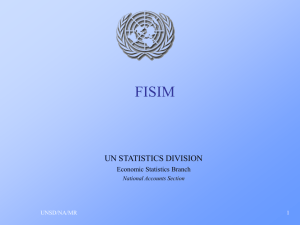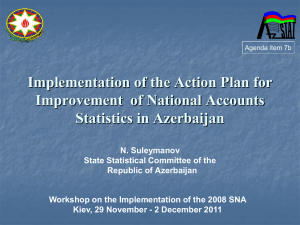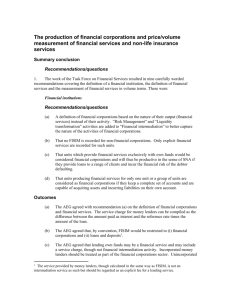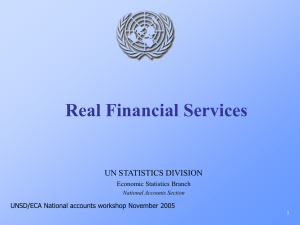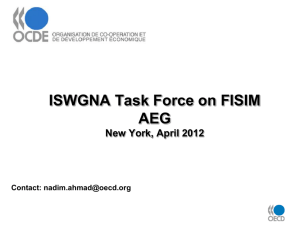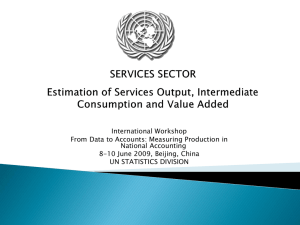Accounting for Credit Default Risk in FISIM Brent Moulton
advertisement
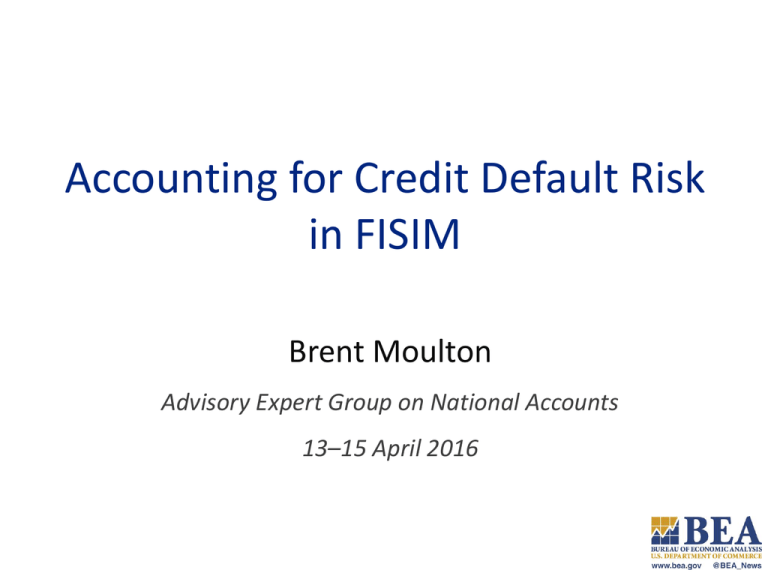
Accounting for Credit Default Risk in FISIM Brent Moulton Advisory Expert Group on National Accounts 13–15 April 2016 Overview • What is credit default risk? • How does it affect measured FISIM? • Should it be included in FISIM? • Proposal to remove credit default margin from FISIM 2 What is credit default risk? • Paper refers to “charge-off rates” – Loan write-offs per period divided by loan balances • Credit default risk – Risk that a loan won’t be repaid – May be measured by expected (normal) charge-off rate (“default margin”) • Credit default risk varies across – Type of loan (credit card versus mortgage) – Time (before and after financial crisis) 3 How does credit default risk affect FISIM? • Financial institutions charge higher interest rates to borrowers with higher credit default risk • Credit default risk is included in borrower FISIM r loan = r reference + s r loan = interest rate on loans, r reference = reference rate, s = FISIM • During periods of higher risk, lenders charge higher interest rates, causing borrower FISIM to grow – In United States (under old SNA 1993 treatment) commercial bank borrower FISIM at current prices increased 45% from 2007 to 2011. – Thus, even though gross lending was flat, measured nominal bank output was increasing 4 Should credit default risk be included in FISIM? • FISIM is a source of funds (instead of explicit fees) allowing financial intermediaries to purchase labor, capital, and intermediate consumption to produce services • But the credit default margin is not available to pay for labor, capital, or intermediate consumption – Analogous to exclusion of adjusted claims from measured services of non-life insurance r loan – d = r reference + s d = default margin 5 Previous Task Force and AEG recommendations • In 2012 issues paper, majority of FISIM task force concluded that credit default risk should be excluded from FISIM, but recommended waiting for Eurostat tests. • At 2012 AEG meeting, majority of AEG supported excluding credit default risk in principle, but recognized that it may be difficult to exclude it in practice. • In 2013 final report, FISIM task force recommended on practical grounds that credit default risk remain part of FISIM, but recommended further research. • At 2013 meeting, AEG could not agree on the conceptual merits of either excluding or including credit default risk and recommended that research continue. 6 Proposal to remove credit default margin • Charge-off rate generally not an appropriate measure of credit default margin – Volatile – Charge-off rates refer to past loans that may have been non-performing for a while – Conceptually, prefer ex ante measure of expected default rate, relevant to interest rates currently being negotiated • Alternative treatment – analogous to SNA 2008 treatment of adjusted claims in non-life insurance: dQ = dQ – 1 + 0.075 (cQ – dQ – 1) Q = quarter, Q – 1 = previous quarter, cQ = charge-off rate Parameter of 0.075 is based on average loan maturity for U.S. banks of about 3 years 7 1985.1 1985.4 1986.3 1987.2 1988.1 1988.4 1989.3 1990.2 1991.1 1991.4 1992.3 1993.2 1994.1 1994.4 1995.3 1996.2 1997.1 1997.4 1998.3 1999.2 2000.1 2000.4 2001.3 2002.2 2003.1 2003.4 2004.3 2005.2 2006.1 2006.4 2007.3 2008.2 2009.1 2009.4 2010.3 2011.2 U.S. banks—actual charge-offs on loans and expected defaults Billions of current dollars, annual rate 200 160 120 80 40 0 Quarter Expected default Total domestic charge-offs, unadjusted 8 Effects of alternative treatment on U.S. national accounts • BEA implemented this alternative treatment as part of its 2013 comprehensive revision • For 2008, reduced overall commercial bank FISIM about 17% • Because borrower services mostly assigned to intermediate consumption, effect on GDP was smaller – Revised down less than 0.1% • Previously published increase in borrower FISIM (in current prices) of 45% from 2007 to 2011 was revised down to about 1%. 9 Proposal doesn’t deal with other issues This proposal is distinct from several other FISIM issues that have been discussed: • There’s an argument that interest on non-performing loans shouldn’t be included in calculation of FISIM borrower services – Our proposal here, however, refers to principal, not interest • Wang and coauthors (Basu, Fernald, Inklaar) have proposed also removing risk premium from FISIM – Default margin refers to expected loss (1st moment) – Risk premium refers to premium required for risk averse investors to hold higher variance debt (2nd moment) – Risk premium includes, and generally larger than default margin • Proposal doesn’t require changes to SNA treatment of loan write-offs in “other changes in assets” account 10 Questions for discussion • Should there be a “next step” in continuing research on this proposal? • If so, what should the next steps be? 11
